|
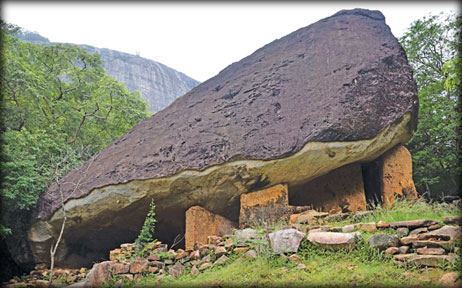
One of the imposing caves |
Namal Pokuna: History atop a hillock
By Mahil Wijesinghe
It was morning and I could see the silhouette of the Dimbulagala
mountain range with its jagged peaks thrusting against the pale blue
sky. The air was a little chilly. The placid water of the Dalukana tank
could be seen on the left side of the road, lying in the foot of the
Dimbulagala hill. Across the tank, a soft, cool breeze blew through the
leaves of trees. The shade and the soothing swishing sound of leaves
mesmerised me. I closed my eyes and breathed in the serenity.
My destination was Dalukana, often referred to as an ‘Adi Vasi’
village, 10 km from Manampitiya, an ancient Adi Vasi village, which was
home to one of the earliest Adi Vasi clans. I was at Namal Pokuna
Rajamaha Vihara, Dalukana, with high expectations of meeting an Adi Vasi
Bhikkhu, Ven. Millane Sri Siriyalankara Thera, who resides in this
temple where Adi Vasis have left marks of their civilisation in caves,
most of which have vanished. Sitting on a bench under a shady mango tree
in front of the spacious compound of the Avasa Ge at the temple on the
foot of the Dimbulagala mountain, the Thera spoke about the temple and
reminisced his childhood with me.
The history of Dimbulagala and its forest hermitage, which had
sheltered thousands of Bhikkhus in the past, dates back to the reign of
King Pandukabhaya. It had been overgrown with creepers after the Chola
invasion and had later become a home for the Adi Vasis.
Millana Yapa, the last chieftain of the clan who lived in these caves
in the Dimbulagala forest for a long time had decided to gift all these
properties to a Bhikkhu along with 12 young Adi Vasi boys, to be
ordained as Samanera Bhikkhus. Ven. Millane Sri Siriyalankara Thera, the
current Viharadhipathi, was one of these 12 boys.
|
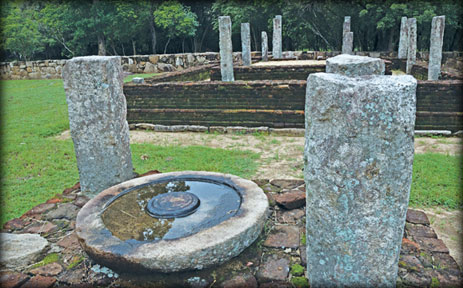
Ruins at the site |
“When we were small, we lived in caves. We didn’t have money. We took
honey, dried meat, maize and fruits such as Mora and Weera to the
Kaduruwela town and sold them, got our provisions and returned to our
caves. Whenever we suffered from any disease, we used our own medicine
based on tribal methods. We bathed in the Avushadha Pokuna (herbal
pond), at the centre of the Dimbulagala mountain, which was believed to
cure all diseases,” the Thera said.
Shrines and hermitages
“These caves were gifted to Ven. Kithalagama Sri Silalankara Thera by
my father, Millana, who was the chieftain of the Adi Vasi village in
Dimbulagala. In place of the caves, he received some mud houses from
areas such as Polonnaruwa and Minneriya. The caves where we lived became
Buddhist shrines and hermitages. Later, my father’s name was changed to
Yapa by the Viharadhipathit because of their close connection”.
“The Viharadhipathi had built a school for us in Horiwila. It was a
very enjoyable life in school,” he said.
Instead of exercise books, those days they carried a slate and a
slate-pencil to school. Returning from school at noon, they would have a
dip in the village tank under the scorching sun, an enthralling
experience for the children.
“I was ordained a Samanera at the age of seven in the Dimbulagala
forest hermitage on June 17, 1965 under the name, Millane Sri
Siriyalankara, along with 11 other Adi Vasi boys. The event received
wide media publicity. However, I am the only one who remains in the
Sasana out of the 12: Some of the others have disrobed while some have
died,” he lamented.
|
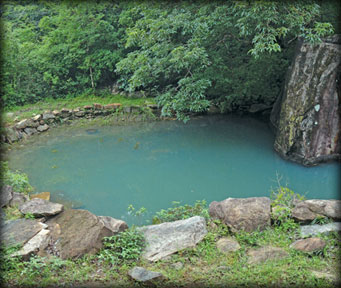
The Avushadha Pokuna (herbal pond) |
|
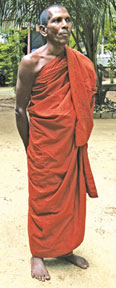
Ven. Millane Sri Siriyalankara Thera |
“My teachers were Ven. Matara Kithalagama Sri Silalankara Thera and
Ven. Udupillegoda Pragnalankara Thera. We got up at 4.00am at the
hermitage. For breakfast, we were given gruel or Kurakkan Thalapa.
“When the Gediya (bell) was rung at around 9.00am, we went for the
Buddha Pooja, and later had our morning meal at the alms hall. Then we
had a short interval around 9.30am, when we would go either to the
Mahaweli river or to a nearby tank to bathe. We would return for the
midday Buddha Pooja and have the midday Dana offered by devotees. Later,
we headed to the Pirivena to study”.
After this conversation, we crossed the main gate of the temple and
started climbing the rocky boulder to explore the ruins of the Namal
Pokuna. The path uphill was dotted with rocky boulders, interspersed
with tall, shade-giving trees.
At last, we saw a man who was the watcher of the Department of
Archaeology, climbing downhill and asked him how far the ruins were. He
merely smiled, shrugged and walked on, but with each stone step we
passed, it seemed that we were going back in time, delving into the
past, to another era. In days of yore, this rock shrine was a reputed
Buddhist pilgrim centre.
Reputed monastery
Around the Polonnaruwa era, it is believed that King Pandukabhaya and
Princess Swarnamali ruled the country from this region. Earlier
Dimbulagala was a reputed monastery for 5,000 Bhikkhus who chose the
hillock for meditation. Almost an hour later, we reached the centre of
the hill where most of the ruins stood amidst the forest canopy. We took
in the charming landscape. The horizontal outline of the Polonnaruwa
ancient city presented a pretty picture against the blue canvas of the
sky. Below, the gleaming lakes, paddy fields, winding rivers, clusters
of villages nestling amid the green carpet were enchanting.
|
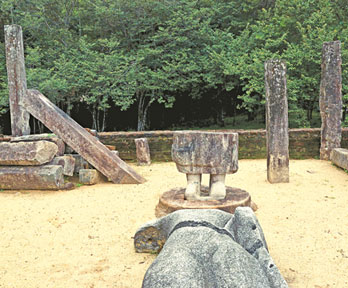
Damaged statues in the compound - torsos of the Buddha |
|
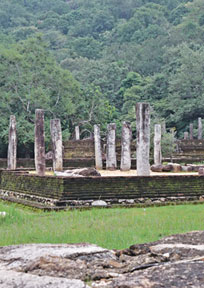
Stone pillars at Namal Pokuna |
We explored the natural caves and stone ruins that have made the
Namal Pokuna famous. What caught my attention on the hilltop were
clusters of ruins such as huge torsos of the Buddha, brick stupas, stone
pillars and stone walls almost resting on each other to form a narrow
path through which one could see the beautiful landscape in the flat
land in the centre of the hill.
Walking around the rock wall, we came across a flight of steps which
took us through the forest canopy to the imposing ruins of several
drip-ledged caves and the Avushadha Pokuna, the jewel of the temple. A
large rectangular pond with steps, it was then used by Bhikkhus to bathe
when they fell sick.
The miracle of this pond, I learnt from the Bhikkhu, was that even in
a severe drought, the water never dries up. It is surrounded by several
drip-ledged caves and lies fully covered by the greenery.
The Namal Pokuna area is considered one of the stone architectural
marvels of the Polonnaruwa period. This temple too faced hard times
during the Chola invasion.
The Namal Pokuna Rajamaha Vihara is not yet spoilt by hordes of
visitors and remains a tranquil spot - a confluence of history and
religion. The serenity you experience at the hill is worth the arduous
uphill climb. |

